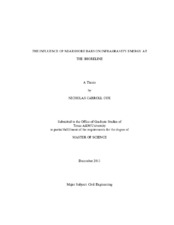| dc.description.abstract | Bathymetric features such as nearshore sandbars can alter local nearshore hydrodynamic processes such as the production of infragravity energy. These bathymetric features may act to reduce or increase the amount of infragravity energy that reaches the shoreline. To determine the influence of the bathymetric features on infragravity energy, the numerical nearshore processes model XBeach was used to simulate infragravity energy at the shoreline. Numerical simulations were completed for three types of bathymetric scenarios: continuous alongshore bar, bar-rip, and no-bar.
The presence of the bar reduces the amount of infragravity energy at the shoreline when compared with the no-bar scenario. This reduction was characterized by modifying an empirical parameterization for significant infragravity swash developed by Stockdon et al. (2006) for barred beaches. Results show that the amount of infragravity energy in the form of swash is dependent on the bar height and depth, in addition to the offshore wave height and wavelength.
The bar-rip bathymetry produces significant alongshore variation in infragravity energy. The alongshore variations may be due to refracted wave energy or the production of an edge wave by the rip. The magnitude of infragravity energy in the alongshore direction is found to be correlated with the surf zone width. Finally, erosion for the bar-rip scenario is studied qualitatively. The shape of the shoreline is modified during storm events, and is found to take the shape of the alongshore distribution of infragravity energy.
Since infragravity swash influences beach erosion, results of this research may be used as part of an erosion vulnerability scale. Such information on erosion vulnerability is important for the design of coastal protection systems and the protection of coastal communities. | en |


